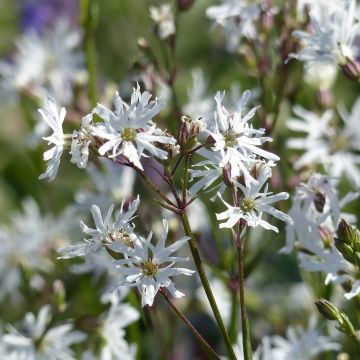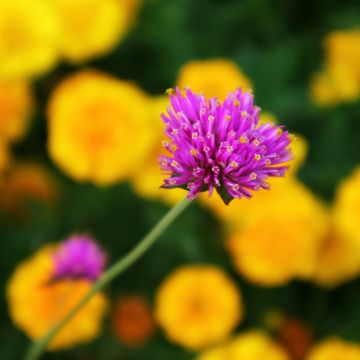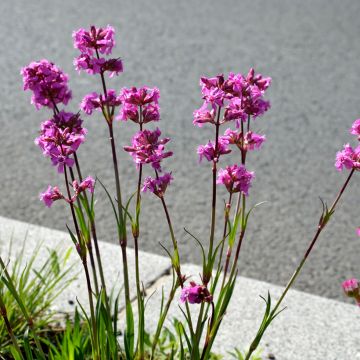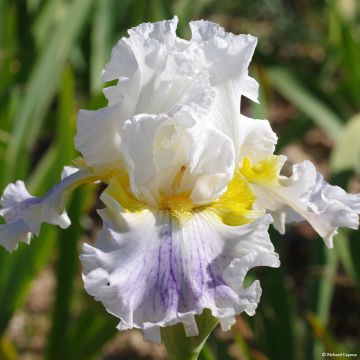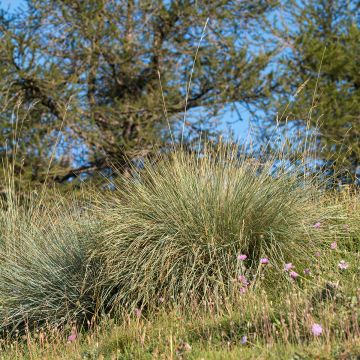

Lychnis coronaria Atrosanguinea


Lychnis coronaria Atrosanguinea


Lychnis coronaria Atrosanguinea


Lychnis coronaria Atrosanguinea
Lychnis coronaria Atrosanguinea
Lychnis coronaria Atrosanguinea
Rose Campion, Dusty Miller, Mullein-pink
This item cannot be shipped to the selected country
Delivery charge from €5.90
Delivery charge from €5.90
More information
Schedule delivery date,
and select date in basket
This plant carries a 12 months recovery warranty
More information
We guarantee the quality of our plants for a full growing cycle, and will replace at our expense any plant that fails to recover under normal climatic and planting conditions.
From €5.90 for pickup delivery and €6.90 for home delivery
Express home delivery from €8.90.
From €5.90 for pickup delivery and €6.90 for home delivery
Express home delivery from €8.90.
Does this plant fit my garden?
Set up your Plantfit profile →
Description
Lychnis coronaria Atrosanguinea, also known as rose campion, is a pretty wild and bushy perennial. Sometimes grown as a biennial due to its short lifespan, it self-seeds abundantly in light soil. With its attractive grey and velvety foliage, with white highlights, it comes alive throughout summer with small flowers of an exceptional carmine red, in a perfect chromatic harmony. Accustomed to rocky soils and difficult conditions, it is the queen of wild, romantic or even rocky gardens.
Lychnis coronaria belongs to the Caryophyllaceae family, native to southern Europe and western Asia. It is a tomentose-white perennial plant, with a woody stump, forming rosettes at the base. From the second year of cultivation, stems emerge from the rosette, reaching 40 to 80cm (16 to 32in) depending on the nature of the soil. They are sturdy, single or have dichotomous branching. The plant quickly forms a 45cm (18in) wide clump. The flowering takes place from June to September, in the form of bouquets of simple flat flowers with 5 petals, 4 to 5cm (2in) in diameter. The flowers are a cheerful magenta pink with long peduncles. Its leaves are oval-oblong, silver-grey, semi-evergreen and tomentose.
Plant the garden rose campion in groups, as a single plant can look slightly awkward. A beautiful display can be achieved with Lychnis coronaria 'Alba': the combination of vibrant magenta pink flowers, pure white flowers, and the silvery velvet foliage of both plants will be spectacular. Rose campions elegantly accompany old or English roses, and also thrive in front of evergreen shrubs such as the dark green Eleagnus ebbingei with its silver young shoots, shrubby wormwoods, and all grey or white foliage. Aromatic plants like sage, thyme, lavender, and rosemary, which require the same growing conditions, can accompany it in poor soils. This plant also makes very nice rustic bouquets.
Report an error about the product description
Lychnis coronaria Atrosanguinea in pictures
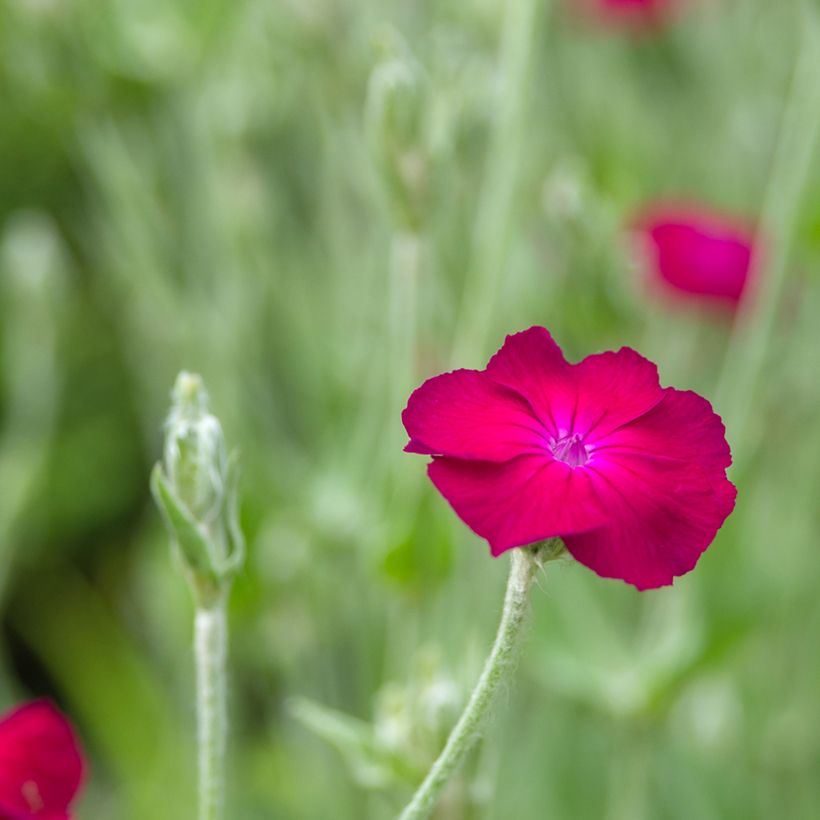



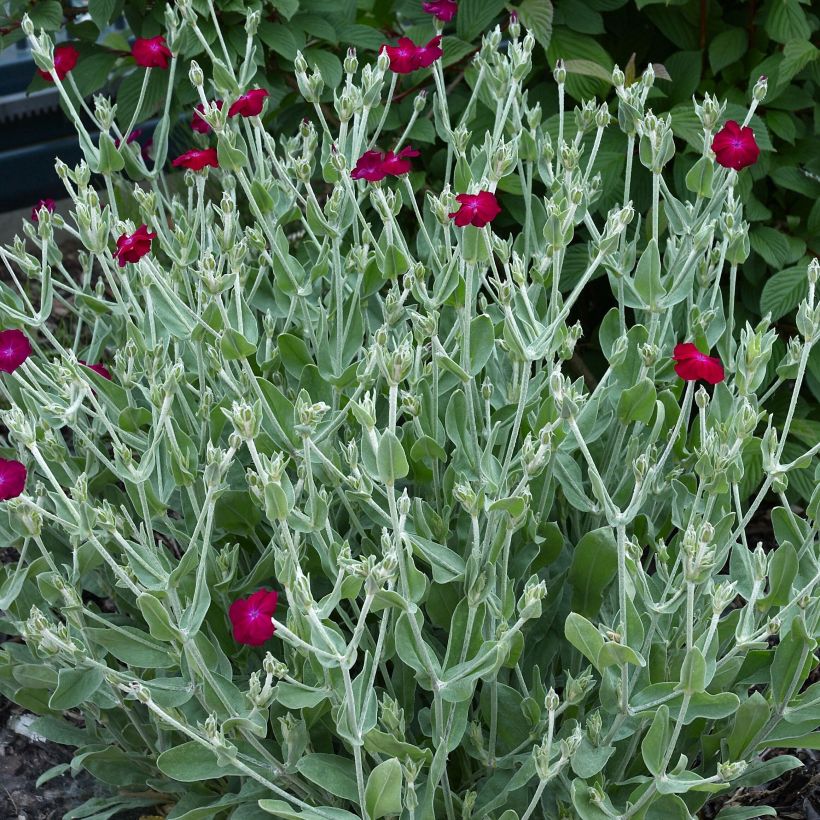

Flowering
Foliage
Plant habit
Botanical data
Lychnis
coronaria
Atrosanguinea
Caryophyllaceae
Rose Campion, Dusty Miller, Mullein-pink
Mediterranean
Other Lychnis
Planting and care
Evergreen down to -30°C (-22°F) (Zone 4 to 8), Lychnis coronaria thrives in sunny or partially shaded locations. This plant is naturally found in uncultivated and rocky areas. Plant it in porous, dry to moist but well-drained, neutral to slightly alkaline soil. Plant it from February to April in cold regions and from September to November in milder ones. In regions with harsh winters, it can be repotted in autumn to protect it from frost. It tolerates drought well, and requires little care and watering. Prune it after flowering to remove dry parts, and promote new growth and a second flowering. The plant self-seeds abundantly.
Planting period
Intended location
Care
-
, onOrder confirmed
Reply from on Promesse de fleurs
Mediterranean perennials
Haven't found what you were looking for?
Hardiness is the lowest winter temperature a plant can endure without suffering serious damage or even dying. However, hardiness is affected by location (a sheltered area, such as a patio), protection (winter cover) and soil type (hardiness is improved by well-drained soil).

Photo Sharing Terms & Conditions
In order to encourage gardeners to interact and share their experiences, Promesse de fleurs offers various media enabling content to be uploaded onto its Site - in particular via the ‘Photo sharing’ module.
The User agrees to refrain from:
- Posting any content that is illegal, prejudicial, insulting, racist, inciteful to hatred, revisionist, contrary to public decency, that infringes on privacy or on the privacy rights of third parties, in particular the publicity rights of persons and goods, intellectual property rights, or the right to privacy.
- Submitting content on behalf of a third party;
- Impersonate the identity of a third party and/or publish any personal information about a third party;
In general, the User undertakes to refrain from any unethical behaviour.
All Content (in particular text, comments, files, images, photos, videos, creative works, etc.), which may be subject to property or intellectual property rights, image or other private rights, shall remain the property of the User, subject to the limited rights granted by the terms of the licence granted by Promesse de fleurs as stated below. Users are at liberty to publish or not to publish such Content on the Site, notably via the ‘Photo Sharing’ facility, and accept that this Content shall be made public and freely accessible, notably on the Internet.
Users further acknowledge, undertake to have ,and guarantee that they hold all necessary rights and permissions to publish such material on the Site, in particular with regard to the legislation in force pertaining to any privacy, property, intellectual property, image, or contractual rights, or rights of any other nature. By publishing such Content on the Site, Users acknowledge accepting full liability as publishers of the Content within the meaning of the law, and grant Promesse de fleurs, free of charge, an inclusive, worldwide licence for the said Content for the entire duration of its publication, including all reproduction, representation, up/downloading, displaying, performing, transmission, and storage rights.
Users also grant permission for their name to be linked to the Content and accept that this link may not always be made available.
By engaging in posting material, Users consent to their Content becoming automatically accessible on the Internet, in particular on other sites and/or blogs and/or web pages of the Promesse de fleurs site, including in particular social pages and the Promesse de fleurs catalogue.
Users may secure the removal of entrusted content free of charge by issuing a simple request via our contact form.
The flowering period indicated on our website applies to countries and regions located in USDA zone 8 (France, the United Kingdom, Ireland, the Netherlands, etc.)
It will vary according to where you live:
- In zones 9 to 10 (Italy, Spain, Greece, etc.), flowering will occur about 2 to 4 weeks earlier.
- In zones 6 to 7 (Germany, Poland, Slovenia, and lower mountainous regions), flowering will be delayed by 2 to 3 weeks.
- In zone 5 (Central Europe, Scandinavia), blooming will be delayed by 3 to 5 weeks.
In temperate climates, pruning of spring-flowering shrubs (forsythia, spireas, etc.) should be done just after flowering.
Pruning of summer-flowering shrubs (Indian Lilac, Perovskia, etc.) can be done in winter or spring.
In cold regions as well as with frost-sensitive plants, avoid pruning too early when severe frosts may still occur.
The planting period indicated on our website applies to countries and regions located in USDA zone 8 (France, United Kingdom, Ireland, Netherlands).
It will vary according to where you live:
- In Mediterranean zones (Marseille, Madrid, Milan, etc.), autumn and winter are the best planting periods.
- In continental zones (Strasbourg, Munich, Vienna, etc.), delay planting by 2 to 3 weeks in spring and bring it forward by 2 to 4 weeks in autumn.
- In mountainous regions (the Alps, Pyrenees, Carpathians, etc.), it is best to plant in late spring (May-June) or late summer (August-September).
The harvesting period indicated on our website applies to countries and regions in USDA zone 8 (France, England, Ireland, the Netherlands).
In colder areas (Scandinavia, Poland, Austria...) fruit and vegetable harvests are likely to be delayed by 3-4 weeks.
In warmer areas (Italy, Spain, Greece, etc.), harvesting will probably take place earlier, depending on weather conditions.
The sowing periods indicated on our website apply to countries and regions within USDA Zone 8 (France, UK, Ireland, Netherlands).
In colder areas (Scandinavia, Poland, Austria...), delay any outdoor sowing by 3-4 weeks, or sow under glass.
In warmer climes (Italy, Spain, Greece, etc.), bring outdoor sowing forward by a few weeks.





































